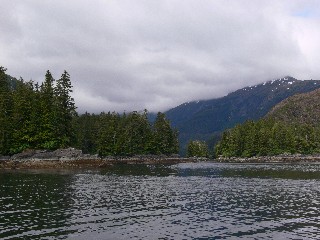
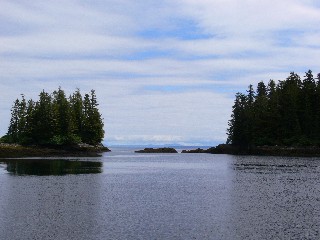
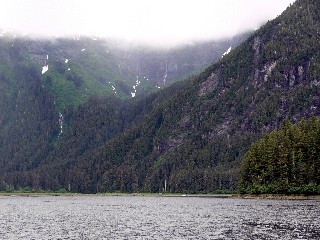
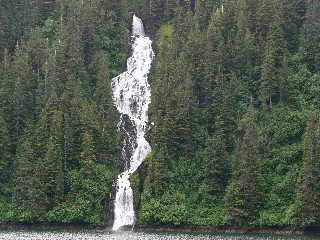
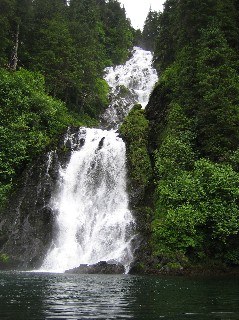
Thursday, June 29, 2006 - We departed Warm Springs Bay at 9:45am for a short run south (15 miles) to Red Bluff Bay which was described to a spectacular anchorage. Along the way we spotted about 8 different whales feeding along the shoreline as well as many waterfalls. As we entered into Red Bluff Bay, we spotted a group of sea lions basking in the SUN on the rocks exposed by low tide. The bay was as described, with red rock cliffs at the entrance, a huge waterfall on the south wall and the high peaks with additional waterfalls cascading down the face. Gypsy had also chose this as their evening destination and we joined Dave and Heather on their boat that evening. We dropped the dingy and placed both our crab traps in between the commercial traps and hoped we would catch dinner again. A 70' Nordhaven had anchored in front of the waterfall in a depth of about 150' but later moved between ourselves and Gypsy when the winds picked up.





Friday, June 30, 2006 - Saturday, July 1, 2006 - We were unable to get any weather reports within Red Bluff Bay, so we decided to lift anchor at 4:30 am and head out into Chatham Strait. The weather was overcast as we headed across Chatham Strait, passing by Kuiu Island and Kupreanof Island into Frederick Sound. Along the way, we spotted about eight different whales feeding in the shallows. We were going to take advantage of a break in the weather (less than 20 knot winds) and make a long run to Petersburg. We arrived at Petersburg at 2:00pm and our only goal was to head up to Coastal Cold Storage (see Chapter 7) and load up on their smoked salmon dip. It was early to bed as we were going to leave in the morning to continue our journey back south. Before leaving Sunday morning, I wandered up the dock and encountered the Kid's Fishing Derby, part of their 4th of July celebration. I could not resist taking a few pictures. The rules were that it was a catch and release program unless it was over 2 lbs and edible. There could be no adult intervention and the children had to bait, cast and bring their catch to the official weigh station. It was hard to tell who got more excited when something was hooked online, the kids or their parents. We departed Petersburg at 9:45am and headed back down the Wrangell Narrows with the thought of staying at Wrangell as we had bypassed it on the way up (see Chapter 6). We were less than two hours out from Wrangell when I called the harbor master on our satellite phone (thank you again, Todd) to inquire as to moorage availability. "We have plenty of room, pick any open space on the dock when you get here", he said. When we were half an hour from the harbor, when we heard another vessel hail the harbor master - his reply was "we are full to capacity and you will need to raft out". We made the decision that we will have to visit Wrangell on our next trip, and proceeded east to the Eastern Passage. We did not want to directly retrace our passage up if there were other alternatives. We decided to spend the night in Berg Bay which was on the mainland side. Berg Bay is off of Blake Channel which connects the Eastern Passage with Ernest Sound. We dropped anchor at 4:30pm and launched the dingy in hopes of crab and to explore the bay. We met Art Capps, his boat is a 41' American Tug named Lucky Puppy. As his traveling companion was in his dingy was wagging his tail and wanting to be petted, the name seemed appropriate. We did not meet his wife, Christina, as she had injured her knee when ashore earlier that day.
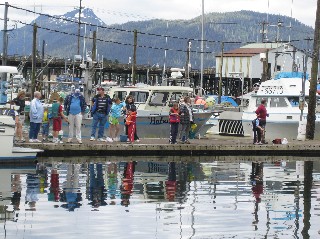
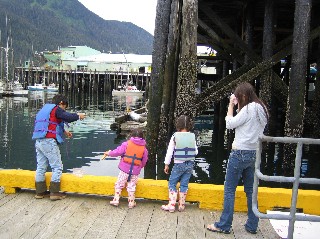
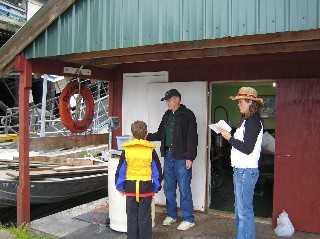
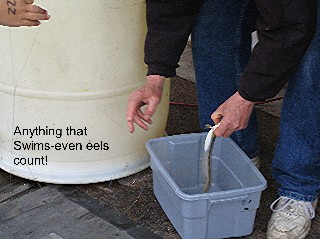
Sunday, July 2, 2006 - We lifted anchor at 9:35am and headed south down Blake Channel to Anan Bay, to see the bears. Anan Wildlife Observatory had been on our list of "must see" on this trip. The forest service had built an observatory which overlooks the waterfalls of Anan Creek and a blind where the bears can be observed up close and personal. On our way up north, it was way to early to see any bear activity so we decided that would make our stop on our way south. Art (Lucky Puppy) said he had been there two days before and was able to anchor as the forest service let him stern tie to their float. He said that even though the fish were late in running there were a few bears to be seen. As we entered the bay and dropped our anchor to find that for a boat our size we were forced over a sandy shoal with a steep drop off. No sooner had we dropped the dingy to go ashore, the winds shifted from the west and were picking up to 20 knots. The boat was rocking and the anchor was dragging and it was not a safe situation to leave the boat unattended. It is somewhat interesting that they have this wonderful observatory that is difficult to access except by seaplane that can be beached. There is no "dingy dock" so even if you were able to anchor, you needed to be able to drag your dingy to shore and secure it against the changing tides while hiking to the observatory. We lifted our anchor and headed south down the Seward Passage to Santa Ana Inlet to spend the night.